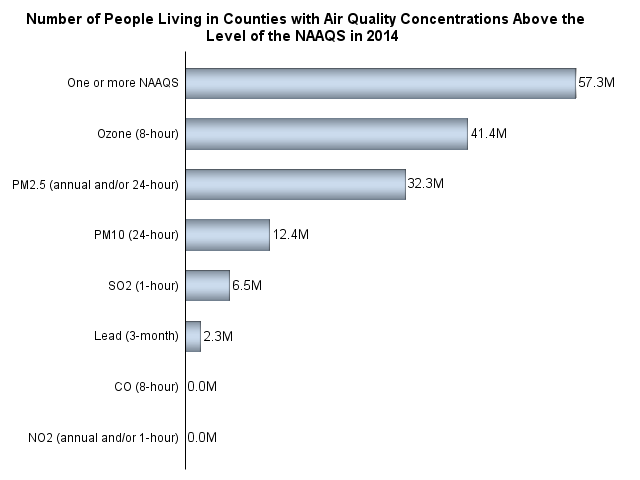Obama Ozone Rule: EPA To Make It Harder For Factories, Power Plants To Emit Smog Pollution
The Obama administration is about to make it harder for factories and power plants nationwide to spew smog-forming pollution. The U.S. Environmental Protection Agency this week is expected to finalize stricter emissions limits on ground-level ozone, which is linked to asthma and respiratory illness.
The current federal limit “is not adequate to protect public health,” Janet McCabe, the EPA’s acting assistant administrator, said Tuesday at a Senate hearing.
Regulators are facing a court-ordered deadline of Oct. 1 to finalize the updated Ozone National Ambient Air Quality Standard. The EPA in November proposed a version of the rule that would cap the highest ozone levels allowed at 65 to 70 parts per billion, from the 75 parts per billion limit set by the Bush administration in 2008.
Environmental groups decried the proposal earlier this week, saying any limit above 60 parts per billion still allows for dangerous levels of air pollution. Manufacturing and industry groups, on the other hand, have argued that toughening the standard would force factories to close and result in steep penalties for local governments.
The EPA estimated the plan would result in up to $38 billion in public health benefits, including fewer asthma attacks and emergency room visits, while costing industries up to $16.6 billion to comply with the tighter rule.
The final rulemaking arrives as Americans are grappling with a separate smog-related headache. Volkswagen this month admitted to designing some of its diesel cars to cheat federal emissions tests, allowing the vehicles to emit as much as 40 times the U.S. legal limit of pollutants, including ozone-forming nitrogen oxides, according to the EPA.
More than 4 in 10 Americans -- or nearly 138.5 million people -- live in areas where pollution levels are often too dangerous to breathe, the American Lung Association found in its State of the Air 2015 report. Inhaling ozone boosts the risks of asthma attacks, bronchitis and premature death, particularly in children and senior citizens. Air pollution worldwide kills around 3.3 million people a year, scientists from Harvard University and other institutions said in a recent study published in the journal Nature.

Public health and environmental organizations said the Obama administration’s smog proposal doesn’t go far enough to protect Americans from lung-related illness. The EPA’s own Children’s Health Protection Advisory Committee has recommended the agency set the limit at 60 parts per billion, noting that 65 to 70 parts per billion -- the range proposed by the EPA -- “will not be sufficient to protect children’s health,” the committee wrote in a 2014 letter.
“Medical science is very clear that the current standard is leaving millions of Americans at risk of very serious health problems,” Mary Anne Hitt, director of the Sierra Club’s Beyond Coal campaign, said on a Monday press call. “Sixty parts per billion is the best choice to protect the health of America’s families.”
The Sierra Club is one of several environmental and health groups that sued the Obama administration in 2011 to force a tougher smog pollution limit. President Barack Obama, who was seeking re-election, spiked an earlier EPA proposal that had drawn fierce scrutiny from Republicans, who warned of increased costs for governments and industries. A federal court ordered the EPA to take action on the smog rule by Dec. 1, 2014, and finalize the rule by Oct. 1.
Republican lawmakers and business groups have brought similar levels of opposition to the newest smog proposal, saying it would push too many parts of the country into noncompliance. Meeting the smog rule requires states to craft plans that slash pollution from industrial sources and vehicles. Critics argue the existing ozone standard of 75 parts per billion is sufficient to protect public health without choking the economy.
Rebecca Rentz, an environmental attorney at Winstead PC who chairs the Greater Houston Partnership’s air quality committee, said cities in Texas already have taken strides to reduce air pollution emissions from factories, refineries and cars. In Greater Houston, ozone levels have dropped 24 percent since 2000, and officials are on track to meet the existing federal standard, she said.
The smog standard “seems to be like a limbo bar that just keeps getting moved lower and lower,” she said. “Our concern is that by moving on to a [new] standard, that’s really going to divert attention and resources away from the progress that’s already being made.”
Rentz said she worried a tougher standard would punish cities that have little control over their ozone levels. Towns with few local industrial facilities can still report high ozone levels from the interstate and international pollution from cars, ships and trains. “It just makes achieving that standard even more expensive locally,” she said.
Both industry and environmental groups are expected to fight the EPA’s upcoming smog standard, depending on the final rule.
David Baron, a managing attorney for Earthjustice, a nonprofit environmental law organization, said, “There’s a good likelihood that we would sue if the Obama administration adopted a 70 parts per billion standard.”
© Copyright IBTimes 2024. All rights reserved.





















